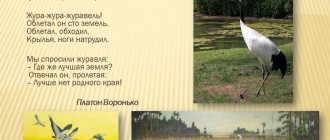Planning educational activities in the senior group "Furniture"
Age group: Senior group
Full name of teacher: Ivleva T.A.
Date: from 01/28/19 to 02/01/19.
Project theme: “My home. Furniture, electrical appliances"
Goal: Creating conditions for cognitive activity through preparation for productive activity.
Final event: Construction “Exhibition of furniture and electrical appliances on the windowsill”
- independent; - group; - subgroup; * - individual.
| Children's Department of Internal Affairs | Days of the week | ||||
| Monday | Tuesday | Wednesday | Thursday | Friday | |
| Directly educational activity | I.9:00 Cognitive development (integration) Topic: “Travel in an apartment” 9:40 Artistic and aesthetic development (Music) II. 15:30 Artistic and aesthetic development (drawing) Topic: “Home Helpers” | I 9:00 Cognitive development (integration) + NQF Topic: “Travel in an apartment” 9:35 Speech development (correct speech) "Stoves-benches" 10:30 Physical development II. 15:30 Artistic and aesthetic development (Music) | I. 9:00 Cognitive development (FEMP) Topic: “Number 8, composition of the number” | I. 9:00 Physical development (Physical education) Speech development (literacy training) Topic: Characteristics of the sound “N” (according to the table: consonant, voiced, hard (soft)). Working with the word scheme, determining the position of sound in words. II. 15:30 Artistic and aesthetic development (Modeling) Topic: “Furniture of my home” | I. 9:00 Physical development (Physical education) II. 15:30 Artistic and aesthetic development (drawing) Topic: “Sofa divanich” |
| Cognitive and research activity | I.Walk: looking at the roofs of houses (materials) II. Looking at the illustrations “My Home” | I. Walk: examining house designs (shape, color, material) II. Travel game “Journey into the past of an object (vacuum cleaner)” Looking at illustrations “Electrical Appliances” | I. Walk: examination of buildings in walking areas (presence, shape, material, use) II. Examination of illustrations “Furniture” | I. Walk: looking at trees (as materials for making furniture) II. D/i “Look, think, count” | I. Walk: examining the street lighting of the kindergarten territory (relationship: lighting = electricity = electrical appliances) II. Educational game “Find 10 differences” |
| Communicative activity | I. D/i “Describe the house” - teach children to write a story and description. II. Game exercise “Let's furnish the apartment” - develop the ability to write descriptive stories according to plan | I. Game “Dangerous-Safe” Creating problematic situations, acting out. II. Guessing riddles about pieces of kitchen and bedroom furniture. | I. Theatrical activity “The Tale of the Brave Hare” II. | I. II. Didactic game “Name it affectionately” - the ability to select diminutive suffixes and consolidate generalized words. | I. Presentation "Furniture". Purpose: to introduce children to surrounding pieces of furniture; learn to identify essential features, group and classify pieces of furniture according to general characteristics; II. |
| Perception of fiction | I. Reading “Fedorino’s Mountain” by K. Chukovsky, discussion of the fairy tale on the topic - furniture. II. Conversation on reading “House with a Chimney” | I. Reading and discussion of the fairy tale “The Three Bears” II. Readings of S. Marshak’s work “Where the Table Came From” | I. Reading the story by L. Panteleev “The Big Wash.” II. V. Chernyaeva “Vasily the Cat and Household Appliances” | I. Learning by heart Levin V.A. "Box" II. V. Dragunsky “He is alive and glowing” | I. II. Reading competition on the topic of the week |
| Constructive activity | I. Construction of “TV” II. Start of creating the “City of My Dreams” layout () | I. Construction of “Wooden construction set” II. Working on the “City of My Dreams” layout | I. Offer a construction kit from the “Make It Yourself” series for building furniture for the living room, kitchen, room and hallway (for S/R games) II. Working on the “City of My Dreams” layout | I. Construction "Large designer" II. Mini-workshop (making furniture for a doll’s house from waste material) – to introduce children to joint work | I. Construction "Soft constructor" II. Construction "Exhibition of furniture and electrical appliances on the windowsill" |
| Play activity | I. Role-playing game “Professions”. II. | I. S/r. game "Furniture Salon". Goal: to form sociocultural components (possession of knowledge and experience) in fulfilling typical social roles: buyer, seller). II. | I. Games in the theater corner (finger theater “Turnip”) II. S/r game "Family" | I. S/r game “Shop” II. | I. Plot-role-playing game “Furniture Salon”: plot “Sale” II. SD/I “Let’s feed the birds” (seeds, crumbs, lard) |
| Visual activities | I. MOLDING “Our Helpers”. Goal: Continue to teach children to use the method of “sticking” plasticine onto a paper surface with a certain contour. II. | I. Independent artistic activity (barbie doll’s kitchen) II. Drawing “House with a chimney” | I. "Furniture for a doll's house." -continue to develop plasticine modeling skills; teach children to sculpt doll furniture II. | I. Independent artistic activity (Barbie doll’s bathroom) II.Drawing “Different types of furniture” | I. Drawing “Complete the detail.” Goal: to teach to recognize utensils, their parts and purpose. II. |
| Perception of works of fine art | I. Examination of illustrations depicting dishes. Goal: developing knowledge about dishes, expanding horizons. II. | I. II. | I. II. Compiling a descriptive story “My Room” | I. II. | I. II. Compiling a descriptive story “Furniture in my house” |
| Musical activities | I. Write a song (words on the topic). Invite children on a walk to convey the rhythm of the words by clapping: bed, chair... II. | I. II. Musical and didactic game “Listen and repeat.” Goal: to teach children to perceive, distinguish and reproduce a rhythmic pattern (on a tambourine, rattle). | I. Musical game: “Guess what it sounds like?” II. | I. II. Musical and didactic game “Listen and repeat.” Goal: to teach children to perceive, distinguish and reproduce a rhythmic pattern (on a tambourine, rattle). | I. II. Musical-dynamic pause |
| Motor activity | I. Game "Hunters and Ducks". Goal: learn to move in accordance with the text, practice running. “A clever couple” Goal: to develop the eye, achieving good results. II. P/game: “At the Bear in the Forest” - develop running, attention, agility, and ingenuity. | I. P/i “Snowflakes and Ice.” Goal: learn to walk clearly, rhythmically, with good posture and coordination of movements. II. "Speed Run" Goal: To develop coordination of movements. | I. “Blind Man’s Bluff” - develop running. II. Round dance: “Burn, burn clearly” - consolidate the movement of the round dance, imagination | I. P/n “We won’t tell you what we did, but we will show you!” Independent play activities of children in activity sectors II. P/games: “Find where it’s hidden” - orientation in space. | I.M.p.i. "Prohibited Movement" Goal: develop attention and dexterity. II. "Speed Run" Goal: To develop coordination of movements. |
| Self-service and labor elements | I. Carry out instructions for caring for furniture and putting things in order in play areas. II. Duty in class. | I. Cleaning up your lockers after a walk. II. Help the teacher clear the paths | I. Instructions: give shovels to a subgroup of children and invite the children to cover trees and bushes. II. Clean the boards from plasticine. | I. II. Pour colored water over the snow, invite children to fill the snow with colored water. | I. Household work: general cleaning in the group room. II.Cleaning in play areas. |
| Interaction with parents | I. Come up with a descriptive story “Furniture in my room” with the children II. | I.Give instructions to parents (selection of masks for theatrical activities) II. | I. II. | I. II.Learning a poem on the topic of the week (independent selection) | I.Give instructions to parents for the coming week. II. |
| Interaction with specialists | I. II.Mus. director-Musical selection for TIR | I. II. | I. Interaction with the physical education director: A selection of finger games on the topic of the week. II. | I. II. | I. Interaction with a teacher-psychologist: “Emotional instability of the pupil” II. |


